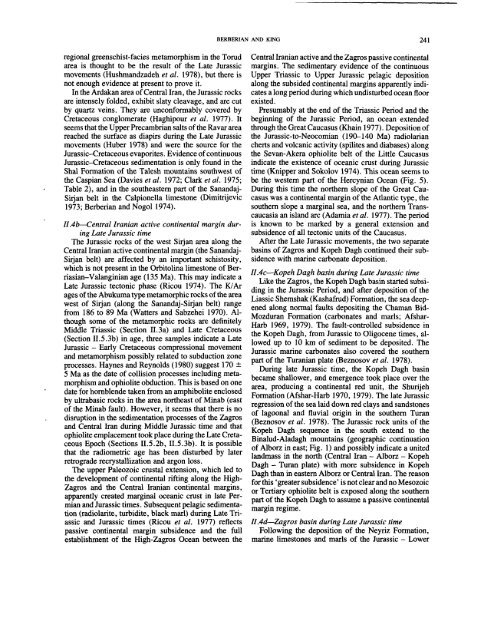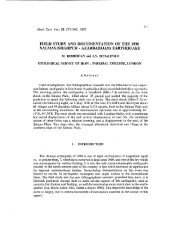PDF COPY - Manuel berberian
PDF COPY - Manuel berberian
PDF COPY - Manuel berberian
You also want an ePaper? Increase the reach of your titles
YUMPU automatically turns print PDFs into web optimized ePapers that Google loves.
egional greenschist-facies metamorphism in the Tomd<br />
area is thought to be the result of the Late Jurassic<br />
movements (Hushmandzadeh et al. 1978), but there is<br />
not enough evidence at present to prove it.<br />
In the Ardakan area of Central Iran, the Jurassic rocks<br />
are intensely folded, exhibit slaty cleavage, and are cut<br />
by quartz veins. They are unconformably covered by<br />
Cretaceous conglomerate (Haghipour et al. 1977). It<br />
seems that the Upper Precambrian salts of the Ravar area<br />
reached the surface as diapirs during the Late Jurassic<br />
movements (Huber 1978) and were the source for the<br />
Jurassic-Cretaceous evaporites. Evidence of continuous<br />
Jurassic--Cretaceous sedimentation is only found in the<br />
Shal Formation of the Talesh mountains southwest of<br />
the Caspian Sea (Davies et al. 1972; Clark et al. 1975;<br />
Table 2), and in the southeastern part of the Sanandaj-<br />
Sirjan belt in the Calpionella limestone (Dimitrijevic<br />
1973; Berberian and Nogol 1974).<br />
H.4b~Central lranian active continental margin during<br />
Late Jurassic time<br />
The Jurassic rocks of the west Sirjan area along the<br />
Central Iranian active continental margin (the Sanandaj-<br />
Sirjan belt) are affected by an important schistosity,<br />
which is not present in the Orbitolina limestone of Berriasian-Valanginian<br />
age (135 Ma). This may indicate<br />
Late Jurassic tectonic phase (Ricou 1974). The K/Ar<br />
ages of the Abukuma type metamorphic rocks of the area<br />
west of Sirjan (along the Sanandaj-Sirjan belt) range<br />
from 186 to 89 Ma (Watters and Sabzehei 1970). Although<br />
some of the metamorphic rocks are definitely<br />
Middle Triassic (Section II.3a) and Late Cretaceous<br />
(Section II.5.3b) in age, three samples indicate a Late<br />
Jurassic - Early Cretaceous compressional movement<br />
and metamorphism possibly related to subduction zone<br />
processes. Haynes and Reynolds (1980) suggest 170 ---<br />
5 Ma as the date of collision processes including metamorphism<br />
and ophiolite obduction. This is based on one<br />
date for hornblende taken from an amphibolite enclosed<br />
by ultrabasic rocks in the area northeast of Minab (east<br />
of the Minab fault). However, it seems that there is no<br />
disruption in the sedimentation processes of the Zagros<br />
and Central Iran during Middle Jurassic time and that<br />
ophiolite emplacement took place during the Late Cretaceous<br />
Epoch (Sections II.5.2b, II.5.3b). It is possible<br />
that the radiometric age has been disturbed by later<br />
retrograde recrystallization and argon loss.<br />
The upper Paleozoic crustal extension, which led to<br />
the development of continental rifting along the High-<br />
Zagros and the Central Iranian continental margins,<br />
apparently created marginal oceanic crust in late Permian<br />
and Jurassic times. Subsequent pelagic sedimentation<br />
(radiolarite, turbidite, black marl) during Late Triassic<br />
and Jurassic times (Ricou et al. 1977) reflects<br />
passive continental margin subsidence and the full<br />
establishment of the High-Zagros Ocean between the<br />
BERBERIAN AND KING 241<br />
Central Iranian active and the Zagros passive continental<br />
margins. The sedimentary evidence of the continuous<br />
Upper Triassic to Upper Jurassic pelagic deposition<br />
along the subsided continental margins apparently indicates<br />
a long period during which undisturbed ocean floor<br />
existed.<br />
Presumably at the end of the Triassic Period and the<br />
beginning of the Jurassic Period, an ocean extended<br />
through the Great Caucasus (Khain 1977). Deposition<br />
the Jurassic-to-Neocomian (190-140 Ma) radiolarian<br />
cherts and volcanic activity (spilites and diabases) along<br />
the Sevan-Akera ophiolite belt of the Little Caucasus<br />
indicate the existence of oceanic crust during Jurassic<br />
time (Knipper and Sokolov 1974). This ocean seems<br />
be the western part of the Hercynian Ocean (Fig. 5).<br />
During this time the northern slope of the Great Caucasus<br />
was a continental margin of the Atlantic type, the<br />
southern slope a marginal sea, and the northern Transcaucasia<br />
an island arc (Adamia et al. 1977). The period<br />
is known to be marked by a general extension and<br />
subsidence of all tectonic units of the Caucasus.<br />
After the Late Jurassic movements, the two separate<br />
basins of Zagros and Kopeh Dagh continued their subsidence<br />
with marine carbonate deposition.<br />
H.4c--Kopeh Dagh basin during Late Jurassic time<br />
Like the Zagros, the Kopeh Dagh basin started subsiding<br />
in the Jurassic Period, and after deposition of the<br />
Liassic Shemshak (Kashafrud) Formation, the sea deepened<br />
along normal faults depositing the Chaman Bid-<br />
Mozduran Formation (carbonates and marls; Afshar-<br />
Harb 1969, 1979). The fault-controlled subsidence in<br />
the Kopeh Dagh, from Jurassic to Oligocene times, allowed<br />
up to 10 km of sediment to be deposited. The<br />
Jurassic marine carbonates also covered the southern<br />
part of the Turanian plate (Beznosov et al. 1978).<br />
During late Jurassic time, the Kopeh Dagh basin<br />
became shallower, and emergence took place over the<br />
area, producing a continental red unit, the Shurijeh<br />
Formation (Afshar-Harb 1970, 1979). The late Jurassic<br />
regression of the sea laid down red clays and sandstones<br />
of lagoonal and fluvial origin in the southern Turan<br />
(Beznosov et al. 1978). The Jurassic rock units of the<br />
Kopeh Dagh sequence in the south extend to the<br />
Binalud-Aladagh mountains (geographic continuation<br />
of Alborz in east; Fig. 1) and possibly indicate a united<br />
landmass in the north (Central Iran - Alborz - Kopeh<br />
Dagh - Turan plate) with more subsidence in Kopeh<br />
Dagh than in eastern Alborz or Central Iran. The reason<br />
for this ’greater subsidence’ is not clear and no Mesozoic<br />
or Tertiary ophiolite belt is exposed along the southern<br />
part of the Kopeh Dagh to assume a passive continental<br />
margin regime.<br />
H.4d--Zagros basin during Late Jurassic time<br />
Following the deposition of the Neyriz Formation,<br />
marine limestones and marls of the Jurassic - Lower







